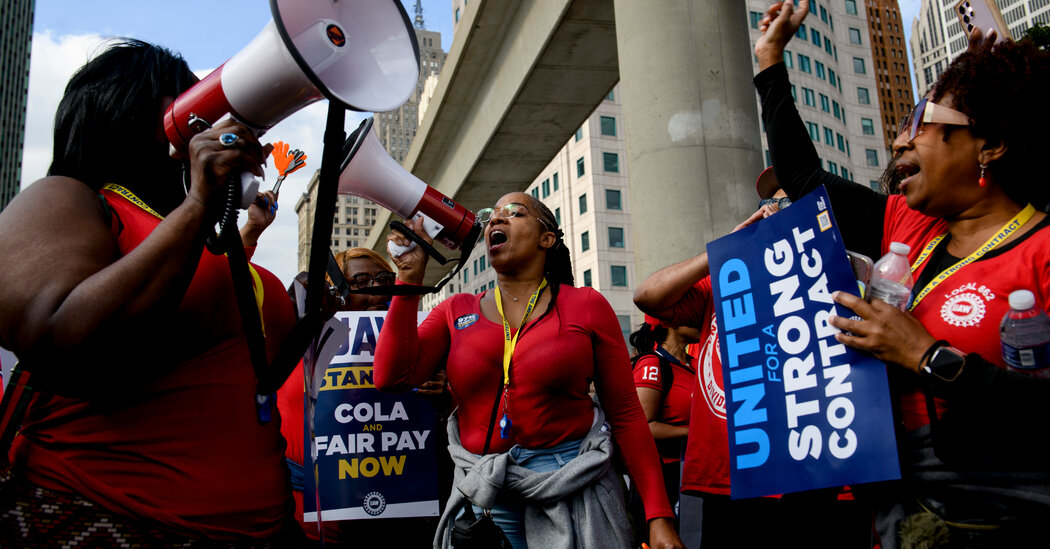

In the wake of the pandemic, labor unions have experienced a notable resurgence. They’ve successfully penetrated previously nonunion corporations like Starbucks and Amazon, securing robust contracts for hundreds of thousands of employees. Public approval for unions recently reached its highest point since the Lyndon Johnson era.
Yet, amidst this resurgence, national labor unions have yet to face a defining, large-scale challenge. Strikes that had the potential to disrupt the U.S. economy, such as those by railroad workers and UPS employees, were narrowly averted. The fallout from ongoing strikes involving writers and actors has been predominantly confined to Southern California.
The United Automobile Workers (U.A.W.), whose members initiated a strike at three plants recently, are now on the cusp of such a defining moment. The outcome of this strike, featuring demands for substantial wage increases and other concessions from major automakers, could establish organized labor as a formidable economic influence and accelerate the current surge in labor organizing efforts.
However, the road ahead is fraught with potential pitfalls. A protracted strike could weaken the positions of the three established U.S. automakers – General Motors, Ford, and Stellantis (which owns Chrysler, Jeep, and Ram) – and push the crucial Midwest region towards recession. If the union is perceived as overreaching or settles for an underwhelming agreement following a costly work stoppage, public support may erode.
“At present, unions are in vogue,” noted Michael Lotito, an attorney at Littler Mendelson, a firm representing management. “However, unions run the risk of falling out of favor if we witness a five-month strike in L.A. and X-month strikes in numerous other states,” he cautioned.
The significance of this challenge is amplified by the U.A.W.’s newly-elected president, Shawn Fain, who has deliberately framed it as a broader struggle between ordinary workers and corporate giants. In frequent video meetings with union members, Mr. Fain characterizes the negotiations as a battle between the working class and the wealthy elite, the haves versus the have-nots, and the billionaire class versus everyone else.
This class-oriented narrative appears to resonate strongly with the union members, with thousands actively participating in these online sessions. Shunte Sanders-Beasley, a U.A.W. member in Michigan, who started her career at a Chrysler plant in Indiana in 1999, shares this perspective. “If you study history, autoworkers often set the tone,” she remarks. She hopes that reclaiming some previously conceded benefits will have a cascading effect.
A successful autoworker strike in 1937, which prompted G.M. to recognize the U.A.W. for the first time, initiated a wave of unionization across diverse industries, including steel, oil, textiles, and newspapers over subsequent years.
Observers agree that the current strike could similarly inspire workers in other industries who have closely monitored labor actions over the past year. Jaz Brisack, an organizer with Workers United, remarks, “In organizing meetings, they say, ‘If they can do it, we can do it.'”
However, it’s important to acknowledge that the strike may unintentionally harm tens of thousands of nonunion workers and their communities.
Jay Timmons, the CEO of the National Association of Manufacturers, emphasizes that the small and medium-sized manufacturers within the automotive sector’s integrated supply chain will bear the brunt of this work stoppage, regardless of their union affiliation.
While higher wages and improved conditions for workers can stimulate the economy, critics argue that the aggressive demands made by Mr. Fain and other labor leaders could dissuade businesses from investing in the United States or render them uncompetitive against foreign rivals.
John Drake, vice president of transportation, infrastructure, and supply chain policy at the U.S. Chamber of Commerce, underscores the importance of considering the long-term financial viability of the automakers.
However, those who support the union’s assertive stance believe it’s necessary. Gene Bruskin, a longtime union official, is a staunch advocate of the strike and Mr. Fain’s approach, which seeks to rally the working class. Nevertheless, he acknowledges that a prolonged strike could disillusion workers if key demands aren’t met.
There’s also concern that the automakers might respond to the strike by shifting more production to Mexico, where they already have a significant presence. President Biden’s substantial federal subsidies for domestic electric vehicle production should help mitigate this shift and preserve manufacturing jobs in the U.S. Still, experts suggest that automakers could explore options like automation and new plants in lightly unionized Southern states.
Despite the challenges, the U.A.W. faces a crucial opportunity. Winning a strong contract in this situation could provide the leverage needed to organize large groups of autoworkers, particularly in nonunionized Southern states, where the union has historically struggled to gain a foothold.
In the realm of labor negotiations, there’s a fine line between being cautious and being ambitious. Organizers stress that workers can become demoralized if union leaders talk tough but ultimately accept subpar deals.
The broad public support for the autoworkers in this strike, as revealed by a recent Gallup poll, sets them apart from the air traffic controllers’ strike in the early 1980s, which ultimately weakened the labor movement. This support suggests that the U.A.W. may be in a unique position to build a broad coalition, increasing the chances of a favorable outcome.
In the end, the U.A.W. strike serves as a litmus test for the labor movement’s resurgence and its potential to effect meaningful change in the modern economy.
PAN Card Application Process: A Complete Guide A Permanent Account Number (PAN) Card is an…
Meet Samuel Edyme, Nickname - HIM-buktu. A web3 content writer, journalist, and aspiring trader, Edyme…
Violet & Daisy, a captivating action-comedy directed by Geoffrey Fletcher, revolves around the lives of…
MBC's latest release, the trailer for episode 5 of "Wonderful World," showcases the captivating performances…
Deadpool 3 & Wolverine Super Bowl Trailer Easter Eggs The Deadpool 3 Super Bowl trailer…
The Nagi Nagi no Mi is a Paramecia-type Devil Fruit with the unique ability to…